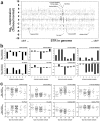A microsatellite repeat in PCA3 long non-coding RNA is associated with prostate cancer risk and aggressiveness
- PMID: 29203868
- PMCID: PMC5715103
- DOI: 10.1038/s41598-017-16700-y
A microsatellite repeat in PCA3 long non-coding RNA is associated with prostate cancer risk and aggressiveness
Abstract
Short tandem repeats (STRs) are repetitive sequences of a polymorphic stretch of two to six nucleotides. We hypothesized that STRs are associated with prostate cancer development and/or progression. We undertook RNA sequencing analysis of prostate tumors and adjacent non-malignant cells to identify polymorphic STRs that are readily expressed in these cells. Most of the expressed STRs in the clinical samples mapped to intronic and intergenic DNA. Our analysis indicated that three of these STRs (TAAA-ACTG2, TTTTG-TRIB1, and TG-PCA3) are polymorphic and differentially expressed in prostate tumors compared to adjacent non-malignant cells. TG-PCA3 STR expression was repressed by the anti-androgen drug enzalutamide in prostate cancer cells. Genetic analysis of prostate cancer patients and healthy controls (N > 2,000) showed a significant association of the most common 11 repeat allele of TG-PCA3 STR with prostate cancer risk (OR = 1.49; 95% CI 1.11-1.99; P = 0.008). A significant association was also observed with aggressive disease (OR = 2.00; 95% CI 1.06-3.76; P = 0.031) and high mortality rates (HR = 3.0; 95% CI 1.03-8.77; P = 0.045). We propose that TG-PCA3 STR has both diagnostic and prognostic potential for prostate cancer. We provided a proof of concept to be applied to other RNA sequencing datasets to identify disease-associated STRs for future clinical exploratory studies.
Conflict of interest statement
The authors declare that they have no competing interests.
Figures





Similar articles
-
Association Analysis of a Microsatellite Repeat in the TRIB1 Gene With Prostate Cancer Risk, Aggressiveness and Survival.Front Genet. 2018 Oct 4;9:428. doi: 10.3389/fgene.2018.00428. eCollection 2018. Front Genet. 2018. PMID: 30337939 Free PMC article.
-
Long noncoding RNA PCA3 gene promoter region is related to the risk of prostate cancer on Chinese males.Exp Mol Pathol. 2014 Dec;97(3):550-3. doi: 10.1016/j.yexmp.2014.11.005. Epub 2014 Nov 11. Exp Mol Pathol. 2014. PMID: 25445501
-
[Association of polymorphism in the promoter region of PCA3 gene with risk of prosate cancer].Zhonghua Zhong Liu Za Zhi. 2015 Feb;37(2):107-12. Zhonghua Zhong Liu Za Zhi. 2015. PMID: 25975686 Chinese.
-
Contemporary role of prostate cancer antigen 3 in the management of prostate cancer.Eur Urol. 2011 Nov;60(5):1045-54. doi: 10.1016/j.eururo.2011.08.003. Epub 2011 Aug 25. Eur Urol. 2011. PMID: 21871709 Review.
-
PCA3: from basic molecular science to the clinical lab.Cancer Lett. 2011 Feb 1;301(1):1-6. doi: 10.1016/j.canlet.2010.10.019. Epub 2010 Nov 18. Cancer Lett. 2011. PMID: 21093148 Review.
Cited by
-
RNA m6a Methylation Regulator Expression in Castration-Resistant Prostate Cancer Progression and Its Genetic Associations.Cancers (Basel). 2024 Mar 27;16(7):1303. doi: 10.3390/cancers16071303. Cancers (Basel). 2024. PMID: 38610981 Free PMC article.
-
Current Progress in Delineating the Roles of Pseudokinase TRIB1 in Controlling Human Diseases.J Cancer. 2021 Aug 21;12(20):6012-6020. doi: 10.7150/jca.51627. eCollection 2021. J Cancer. 2021. PMID: 34539875 Free PMC article. Review.
-
Long non-coding RNA HOTTIP promotes prostate cancer cells proliferation and migration by sponging miR-216a-5p.Biosci Rep. 2018 Sep 28;38(5):BSR20180566. doi: 10.1042/BSR20180566. Print 2018 Oct 31. Biosci Rep. 2018. PMID: 29884766 Free PMC article.
-
Association Analysis of a Microsatellite Repeat in the TRIB1 Gene With Prostate Cancer Risk, Aggressiveness and Survival.Front Genet. 2018 Oct 4;9:428. doi: 10.3389/fgene.2018.00428. eCollection 2018. Front Genet. 2018. PMID: 30337939 Free PMC article.
-
Retracted Article: Long noncoding RNA PCA3 regulates glycolysis, viability and apoptosis by mediating the miR-1/CDK4 axis in prostate cancer.RSC Adv. 2018 Nov 8;8(66):37564-37572. doi: 10.1039/c8ra08083f. eCollection 2018 Nov 7. RSC Adv. 2018. Retraction in: RSC Adv. 2021 Feb 2;11(11):5894. doi: 10.1039/d1ra90066h. PMID: 35558606 Free PMC article. Retracted.
References
Publication types
MeSH terms
Substances
LinkOut - more resources
Full Text Sources
Other Literature Sources
Medical
Miscellaneous

